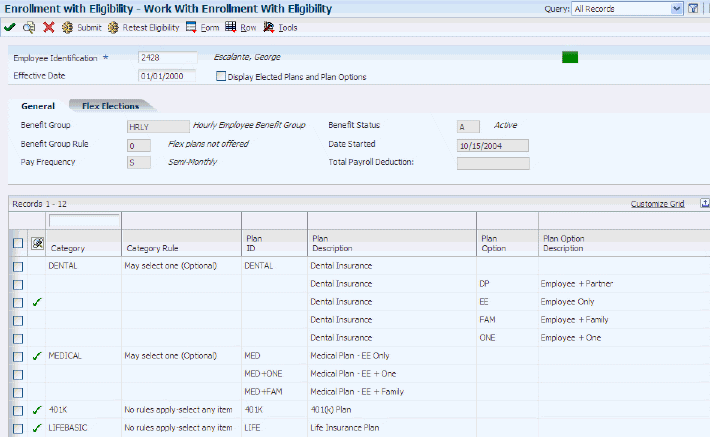11 Working With Flexible Benefits
This chapter contains the following topics:
11.1 Understanding Flexible Benefits
Flexible benefit plans, also called flex plans, enable employees to select the benefit choices that meet their needs. Employers provide employees with flex credits that they can use to purchase the benefit plans that they want. Flex credits can be provided in a lump sum that is based on factors such as length of service or in a lump sum that is the same for all employees. Flex credits can also be awarded upon selection of specified benefit plans.
Each benefit plan has corresponding costs or credits. Plans that are less costly to the employer have a lower flex cost to the employee. For example, a medical plan that includes family coverage might cost an employee 15 flex points, while an employee-only medical plan might cost only 5 flex points. A plan that is particularly inexpensive might carry a flex credit to encourage employees to select that plan over a more costly plan.
Organizations typically use one of these methods to administer flexible benefit plans:
-
The employer provides a single lump sum of flex credits that employees can use to purchase any benefits covered, including medical, dental, and specified disability plans.
-
The employer provides a single lump sum or multiple lump sums of flex credits that can be used only to purchase a specific category of benefits.
For example, an employer might provide a 200.00 USD (United States Dollars) per month flex credit that the employee uses to purchase medical coverage, as well as a 50.00 USD per month flex credit that can be used to purchase dental insurance.
When an employee selects a combination of benefit plans for which the cost exceeds the credits available to the employee, the difference is deducted from the employee's pay through a pretax payroll deduction.
Benefits administrators can enroll employees in flex benefit plans through the Enrollment with Eligibility program (P08334). Employees can also enroll themselves through the self service benefits programs. In both cases, the system maintains a running total of flex credits that are available, spent, and remaining for each employee.
11.2 Understanding Enrolling in Flex Benefit Plans
You can enroll employees in flex benefit plans using the Enrollment with Eligibility program (P08334). You can also let employees enroll themselves in benefit plans using the self service programs. In either case, enrolling in flex plans follows the same process as enrolling in plans that are not flex plans.
The only visible difference between flex and non-flex enrollment is the information that appears on the enrollment form. If a benefit group does not offer flex plans, the system displays the total employee payroll deduction as plan elections are made. If a benefit group offers flex plans, the system dynamically updates various flex amounts on the enrollment form.
Figure 11-1 Work With Enrollment With Eligibility form

Description of "Figure 11-1 Work With Enrollment With Eligibility form"
This table describes how the system calculates the information in the fields on the Flex Elections tab for flex benefit plans:
| Field | Calculation |
|---|---|
| Flex Credits Available | Flex credits available are calculated as the total of the flex credits that are awarded in a lump sum and the flex credits that are awarded as a result of enrolling in specific plans. |
| Flex Credits Spent | Flex credits spent are the total flex credits that an employee used to enroll in selected plans. |
| Flex Credits Remaining | Flex credits remaining are the flex credits spent subtracted from the flex credits that are available. If the remaining flex credits are a negative amount, the system displays a message that indicates that the employee has overspent flex credits, which results in a flex payroll deduction. The system automatically updates the deduction, benefits, accrual (DBA) that is referenced in the employee flex deduction plan with the amount of the negative remaining balance.
If the organization tracks and rewards positive remaining credits, the benefits administrator must manually enter that amount in the appropriate plan DBA. |
| Non Flex Payroll Deduction | The non-flex payroll deductions amount represents the total cost of non-flex plans in which an employee has enrolled. The system displays this amount for enrollment in groups that offer flex plans. |
| Flex Payroll Deduction | The flex payroll deduction is the amount that results from an employee overspending flex credits. The system displays this amount only if the remaining flex credits amount is negative. |
| Total Payroll Deductions | The total payroll deductions represent the total amount that will be deducted from an employee's pay per pay period to pay for benefit plans. This amount is the total of non-flex payroll deductions and the flex payroll deduction. |